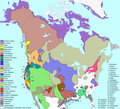Abruozdielis:Langs N.Amer.png

Parvaizos dėdloms: 661 × 600 pikselē. Kėtū dėdlomu: 265 × 240 pikselē | 529 × 480 pikselē | 847 × 768 pikselē | 1 129 × 1 024 pikselē | 1 290 × 1 170 pikselē.
Pradėnis abruozdielis ((1 290 × 1 170 taškū, faila dėdoms: 599 KiB, MIME tips: image/png))
Abruozdielė istuorėjė
Paspauskėt ont deinas/čiesa, ka paveizietomėt abruozdieli, kāp ons ėšruodė pradiuo.
| Dėina/Čiesos | Pamažėnėms | Mierā | Nauduotuos | Paāškėnėms | |
|---|---|---|---|---|---|
| vielībs | 20:28, 20 lėipas 2019 |  | 1 290 × 1 170 (599 KiB) | Denniss | Reverted to version as of 21:52, 1 March 2009 (UTC) |
| 19:54, 13 lėipas 2019 |  | 1 290 × 1 170 (840 KiB) | Thylacinus cynocephalus | Having colonial borders on an indigenous language map is offensive | |
| 00:52, 2 kuova 2009 |  | 1 290 × 1 170 (599 KiB) | Malus Catulus | optipng, pngout | |
| 17:31, 22 groudė 2006 |  | 1 290 × 1 170 (668 KiB) | Mahahahaneapneap | pngcrushed | |
| 03:43, 11 lapkristė 2006 |  | 1 290 × 1 170 (916 KiB) | Ish ishwar | update | |
| 07:55, 1 balondė 2006 |  | 1 296 × 1 176 (678 KiB) | Locke Cole | smaller file (pngout /f0 Langs_N.Amer.png /b4096) / Change: -315546 bytes ( 68% of original) | |
| 07:01, 7 sausė 2006 |  | 1 296 × 1 176 (986 KiB) | Ish ishwar | adai,chimariko = unclassified; adjust uto-aztec, salinan, southern athabasc., muskogean; + Isla Ángel de la Guarda, Isla del Tiburón, Lake Okeechobee | |
| 00:24, 10 groudė 2005 |  | 1 318 × 1 195 (714 KiB) | Ish ishwar | checker grid pattern to Chumash | |
| 09:12, 6 groudė 2005 |  | 1 318 × 1 195 (714 KiB) | Ish ishwar | forgot seri, fix fam key | |
| 04:21, 6 groudė 2005 |  | 1 318 × 1 195 (712 KiB) | Ish ishwar | update |
Abruozdieliu nauduojėms
Ons poslapis ruod ton abruozdielin:
Abruozdielė nauduojėms vėsor
Tėi viki poslapē nauduo šėton abruozdieli:
- Skvarmas nauduojėms af.wikipedia.org
- Skvarmas nauduojėms an.wikipedia.org
- Skvarmas nauduojėms ar.wikipedia.org
- Skvarmas nauduojėms azb.wikipedia.org
- Skvarmas nauduojėms az.wikipedia.org
- Skvarmas nauduojėms be-tarask.wikipedia.org
- Skvarmas nauduojėms beta.wikiversity.org
- Skvarmas nauduojėms be.wikipedia.org
- Skvarmas nauduojėms bg.wikipedia.org
- Skvarmas nauduojėms br.wikipedia.org
- Skvarmas nauduojėms ca.wikipedia.org
- Skvarmas nauduojėms ca.wikimedia.org
- Skvarmas nauduojėms cs.wikipedia.org
- Skvarmas nauduojėms cv.wikipedia.org
- Skvarmas nauduojėms da.wikipedia.org
- Skvarmas nauduojėms da.wikibooks.org
- Skvarmas nauduojėms de.wikipedia.org
- Skvarmas nauduojėms dsb.wikipedia.org
- Skvarmas nauduojėms en.wikipedia.org
- History of the Americas
- North America
- Native Americans in the United States
- First Nations in Canada
- Linguistics and the Book of Mormon
- Lower Rio Grande Valley
- User:Ish ishwar
- Classification of the Indigenous languages of the Americas
- Wikipedia:Featured pictures thumbs/03
- Indigenous peoples of the Americas
- Wikipedia:Wikipedia Signpost/2005-12-26/Features and admins
- Wikipedia:Featured picture candidates/December-2005
- Wikipedia:Featured picture candidates/Indigenous language families north of Mexico
- User:Cyde/Featured pictures
- Talk:New World
- Wikipedia:Picture of the day/April 2006
- Wikipedia:POTD/April 1, 2006
- Wikipedia:Picture of the day/April 1, 2006
- Wikipedia:Today's second feature/April 1, 2006
- Portal:North America/Selected picture
- User talk:Wapcaplet/Archive 3
- Wikipedia:POTD column/April 1, 2006
- Wikipedia:POTD row/April 1, 2006
- User talk:Ish ishwar/2005talkpage
Veizietė, kāp vėsor tasā abruozdielis nauduojams īr.


